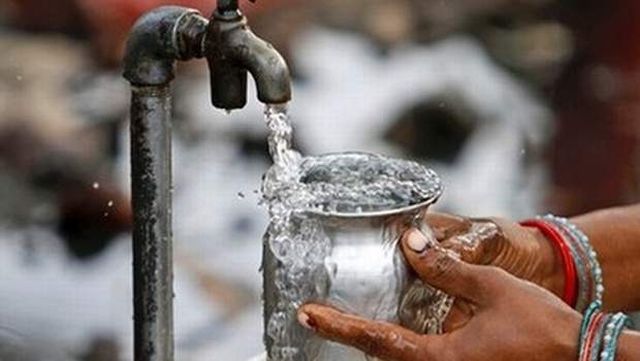Natabar Khuntia
Water is life. United Nations General Assembly recognises in a resolution in July, 2010 the right to water and sanitation and acknowledges that clean drinking water and sanitation are essential to the realisation of all human rights .The resolution call upon the states and international organisations to provide financial resources , help capacity building and technology transfer to help countries in particular developing countries to provide safe affordable drinking water and sanitation for all . Water is a fundamental human need. Each person on earth requires at least 20 to 50 litres of clean, safe water a day for drinking, cooking and simply keeping themselves clean. Polluted water is not just dirty but it is deadly. Some 1.8 million people die every year of diarrhoea diseases like cholera in world over.
The accelerated rural water supply programme was introduced during 1972 73 by government of India to assist states and union territories to accelerate the pace of coverage of drinking water supply. Again, in 2009 National Rural Drinking Water Programme was launched in order to emphasize on ensuring sustainability of availability of portability, adequacy, convenience, affordability and equity decentralised approach.
In spite of launching of different types of drinking water supply programs since 1972 in India, the present water supply situation is alarming throughout the country.
Odisha is also facing crisis in supplying water to her people. Forget the supply of safe drinking water to the people, as many as 68 lakhs people of the rural Odisha cannot have access to simple water even to meet bare minimum need of 40 litres per head per day. When it comes to safe drinking water via pipelines Odisha looks all set to miss the deadline set earlier by 2022.
We hear in-between that hundreds of tribal people die due to cholera. Cholera is a waterborne contagious disease caused by contaminated drinking water. During 2010 hundreds of tribal people died due to cholera in undivided Koraput district. They drank contaminated water from springs and small pits(Chua) At present the entire state is reeling under heatwave . Several district of the state are facing acute drinking water crisis. We are viewing in television screens how the villagers walk for kilometres to fetch drinking water and that from chua (water collected by digging stream or river beds). They filter the contaminated water by using cloths to use for their daily needs. This water is not safe for drinking. In some districts of Odisha such as Nuapada and Angul, high concentration of fluoride in groundwater is a matter of great concern. Consumption of excessive fluoride in drinking water causes dental decay and physiological deformities Ground water of some of the coastal areas is also unfit for drinking as aquifer is severely contaminated by seawater intrusion with 5 to 9 kilometres wide track leaving the ground water unfit for drinking. In iron minining and coal mining areas groundwater is contaminated with fluoride iron and other minerals which make groundwater unsuitable for drinking. It is being observed that many of the industries without treating their wastewater are releasing to rivers which contaminates river water. In Odisha, it is not only the non-availability of water, at the same time water is often contaminated making water unfit for drinking. Supply of safe drinking water in Odisha is a very complex problem. Only if an integrated approach is made to solve the drinking water problem, Odisha may be able to ensure safe drinking water to its citizens in another five years. The newly appointment Panchayati Raj and Drinking Water Minister has said recently, “Our aim will be to find ways to ensure safe drinking water to people of Odisha. We are planning to take steps towards this. We have targeted all rural areas by the end of 2024. We are committed to that and taking steps in this regard.” In order to achieve this target the following steps should be taken so that the target of providing safe drinking water to all may be achieved by 2024.
- Importance should be given to harvest and store rain water in traditional water bodies like katta, bandh sagar, pond and creation of small ponds in farmers’ fields both for irrigation and drinking water since annual rainfall is about 1,450 mm in the state.
- Do not allow industrial waste to be released into the rivers without treatment.
- Open defecation should completely be stopped.
- Shallow tube-wells should be avoided in saline, fluoride and iron belt areas. Deep tube-wells, wherever feasible, should be encouraged.
- In cyclone-prone area instead of overhead tanks underground tanks should be preferred.
- Improved solar pumps to be installed to lift water 7. Nowadays there are quite a good number of buildings both in urban and rural areas. Rain water from terrace should be harvested by introducing modern harvesting system for using drinking and other household purposes.
- Acute poverty, lack of awareness and age-old social practices make the situation even more alarming for Odisha so far as safe drinking water is concerned. There is need to launch safe drinking water awareness programmes among people.
- The government should prepare an integrated, time-bound programme taking into confidence all stakeholders such as the civil society, non-government organisations working for water , industrial houses and consumers and monitor regularly to achieve the goal of ensuring safe drinking water to all by 2024 otherwise the goal will remain as a pipe dream.
The writer is an agro-banker and columnist. e-Mail: natabarkhuntia1@gmail.com.







































